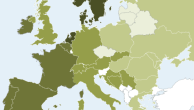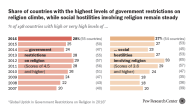Countries with the most extensive government restrictions on religion

Most countries in the world have some form of government restrictions on religion, but each year a few countries stand out as having particularly extensive restrictions.
In 2014, 16 of the 198 countries included in the study had a “very high” level of government restrictions, down from 18 countries in 2013.13 Most of the countries in this category – including China, Egypt, Uzbekistan, Turkey and Indonesia – already had very high restrictions. However, four countries – Kazakhstan, Laos, Maldives and Turkmenistan – had very high government restrictions in 2014 but not in 2013. Six countries that had very high government restrictions in 2013 did not in 2014: Afghanistan, Burma (Myanmar), Sudan, Brunei, Eritrea and Singapore.
The number of countries with high government restrictions went down slightly between 2013 and 2014 (from 37 to 32). By contrast, the number of countries with moderate restrictions went up, from 45 to 57. Meanwhile, 93 countries (47%) had low levels of government restrictions in 2014, slightly less than in 2013 (98 countries, or 49%). For a complete list of all countries in each category, see the Government Restrictions Index table in Appendix A.14
Countries with the most extensive religious hostilities

As is the case with government restrictions, some countries stand out for having very extensive social hostilities involving religion.
The number of countries and territories with a “very high” level of social hostilities involving religion fell from 17 in 2013 to 11 in 2014.15
Many of the countries and territories in this category – including India, Israel, Pakistan, the Palestinian territories and Nigeria – already had very high social hostilities. Two countries – Lebanon and Yemen – had very high social hostilities in 2014 but not in 2013. Eight countries that had very high social hostilities in 2013 did not in 2014: Bangladesh, Central African Republic, Egypt, Indonesia, Kenya, Russia, Somalia and Tanzania.
The number of countries with a high level of social hostilities fell from 36 (18%) in 2013 to 34 (17%) in 2014. The number of countries with a moderate level of social hostilities stayed the same (55). Meanwhile, 98 countries (49%) had low levels of social hostilities in 2014, compared with 90 countries (45%) in 2013. For a complete list of all countries in each category, see the Social Hostilities Index table in Appendix B.16
Changes in government restrictions on religion

Each year, some countries experience significant changes in their scores on the Government Restrictions Index without necessarily rising into – or falling out of – the “very high restrictions” category. Looking only at countries with very high government restrictions would overlook these important dynamics. For this reason, Pew Research Center analyzes changes in government restrictions among all countries – not just those with a very high level of government restrictions – in order to provide greater insight into the nature of government restrictions on religion around the world.
Just one country – Angola – had a large change (2.0 points or more) on the Government Restrictions Index in 2014, and it was in the direction of lower restrictions. There was more government intervention in cases of discrimination or abuse against religious groups and less government violence toward minority religious groups.
Among the 26 countries with modest changes in their GRI scores (1.0 to 1.9 points), six had increases and 20 had decreases. Kazakhstan and the Czech Republic were among the six countries with modest increases; among other things, both countries experienced an increase in government regulation of religious dress.17 In western Kazakhstan, a court held that a preschool was within its rights when it prohibited a young girl from wearing a head-covering hijab because it violated the school’s dress code. The girl’s parents later removed her from the school.18 In the Czech Republic, women were banned from wearing hijabs in some circumstances. For instance, a school of nursing in Prague banned women from wearing headscarves in class. At least two women left the school as a result of the ban. One of them later filed a complaint with the Ministry of Education, whose ombudsman termed the ban discriminatory. The school did not abandon the policy, however, and, as recently as 2016, at least one lawsuit related to the ban was ongoing.19
Albania was one of 20 countries (10%) with modest decreases in their GRI scores in 2014, meaning changes of 1.0 to 1.9 points. Although the country continued to have issues regarding the return of religious properties seized by the government during the country’s decades-long Communist era, some progress was reported. For example, the government completed the return of four properties to the Orthodox Church; it restored one property to the Roman Catholic Church; and it compensated the Muslim community in the city of Shkoder for one property.20 In addition, Albania’s Parliament passed a law in July 2014 allowing the creation of religious cemeteries, which had been banned by the government since the late 1960s.21
Among countries with small changes on the Government Restrictions Index (less than one point), 51 (26%) had increases and 71 (36%) had decreases.
Changes in social hostilities involving religion

Some countries may experience significant changes in their scores on the Social Hostilities Index irrespective of whether they have “very high” levels of social hostilities. This section looks at the extent and direction of those changes from 2013 to 2014.
Among the seven countries with large changes (2.o points or more) in their scores on the 10-point Social Hostilities Index between 2013 and 2014, three had increases and four had decreases. The three countries with large increases were Jordan, Malaysia and the United States.22
In Jordan, tensions over religious conversions sometimes led to violent clashes. In May 2014, for example, a man from the northern city of Ajloun confessed to killing his daughter after she converted from Christianity to Islam. The murder, and subsequent disputes over whether the woman should be buried in a Muslim or Christian cemetery, set off two days of protests and violent encounters in which protestors burned several houses. Clashes subsided only after tribal leaders intervened and the government dispatched security forces.23 In several other instances, people who had converted reported being ostracized, threatened or physically abused by their families or religious leaders.24
Among the factors that contributed to the increase in social hostilities in the United States was an uptick in anti-Semitic activities. For example, the Anti-Defamation League reported that members of the Ku Klux Klan increased their distribution of racist and anti-Semitic fliers.25 There also were reports of Jewish establishments being vandalized in several parts of the country, including several incidents in February 2014 involving a Jewish delicatessen and bakery in Albuquerque, New Mexico.26 More than half of the incidents of anti-religious hate crimes in the U.S. in 2014 (58%) were motivated, in whole or in part, by anti-Jewish bias, according to the FBI; 16% of the incidents were motivated by anti-Muslim bias. 27
The four countries where social hostilities declined by two points or more from 2013 to 2014 were Bangladesh, Nepal, Romania and Tanzania. In Bangladesh, for instance, incidents of sectarian violence, religion-related mob violence and harassment of women for religious dress all declined.
Of the 40 countries (20%) that had modest changes (1.0 to 1.9 points) in their scores in 2014, 12 had increases and 28 had decreases. One of the countries that had a modest increase was Laos, where the growth of Christian congregations, coupled with scarce resources in rural communities, led to increasing tensions with the country’s Buddhist majority. In March 2014, for instance, six families that had converted to Christianity were forced to leave the southern village of Natahall after their religious practices caused friction with village elders.28
In the 97 countries (49%) that had small changes in their scores (less than one point), 48 (24%) had increases and 49 (25%) had decreases.
Changes in overall restrictions on religion

In addition to analyzing government restrictions and social hostilities separately, Pew Research Center also considers government restrictions and social hostilities together. This provides insight into the overall extent of religious restrictions in a country.
Looking at changes in overall restrictions, more countries experienced decreases than increases between 2013 and 2014. Among the six countries whose scores changed by 2.0 points or more on either of the indexes, one had an increase and five had decreases. And among countries whose scores changed by 1.0 to 1.9 points, 16 had increases and 34 had decreases.
Overall, restrictions increased at least somewhat in 71 countries (36%) and decreased in 101 (51%).




